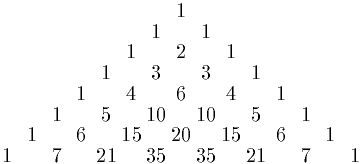25
2
In Pascal's triangle each number is the sum of the two numbers directly above it, treating empty spots as zero:
By rotating the triangle, we can cut out square matrices of varying sizes and rotations which I will call Pascal's matrices. Note that those matrices always need to contain the top \$1\$. Here are some examples:
1 1 1 1
1 2 3 4
1 3 6 10
1 4 10 20
6 3 1
3 2 1
1 1 1
1 5 15 35 70
1 4 10 20 35
1 3 6 10 15
1 2 3 4 5
1 1 1 1 1
1
1 1
2 1
The Task
Given a square matrix containing positive numbers in any reasonable format, decide if it is a Pascal's matrix.
Decide means to either return truthy or falsy values depending on whether the input is a Pascal's matrix, or to fix two constant values and return one for the true inputs and the other for false inputs.
This is code-golf, so try to use as few bytes as possible in the language of your choice. The shortest code in each language wins, thus I will not accept an answer.
Test cases
True
[[1, 1, 1, 1], [1, 2, 3, 4], [1, 3, 6, 10], [1, 4, 10, 20]]
[[6, 3, 1], [3, 2, 1], [1, 1, 1]]
[[1, 5, 15, 35, 70], [1, 4, 10, 20, 35], [1, 3, 6, 10, 15], [1, 2, 3, 4, 5], [1, 1, 1, 1, 1]]
[[1]]
[[1, 1], [2, 1]]
False
[[2]]
[[1, 2], [2, 1]]
[[1, 1], [3, 1]]
[[1, 1, 1, 1], [1, 2, 3, 4], [1, 4, 6, 10], [1, 4, 10, 20]]
[[6, 3, 1], [1, 1, 1], [3, 2, 1]]
[[2, 2, 2, 2], [2, 4, 6, 8], [2, 6, 12, 20], [2, 8, 20, 40]]
[[40, 20, 8, 2], [20, 12, 6, 2], [8, 6, 4, 2], [2, 2, 2, 2]]
[[1, 5, 15, 34, 70], [1, 4, 10, 20, 34], [1, 3, 6, 10, 15], [1, 2, 3, 4, 5], [1, 1, 1, 1, 1]]

Suggested test case:
[[40, 20, 8, 2], [20, 12, 6, 2], [8, 6, 4, 2], [2, 2, 2, 2]]. My initial answer was incorrectly truthy for this one, but correct for all of the current test cases. – Kevin Cruijssen – 2019-03-19T09:40:51.400@KevinCruijssen Thanks, added. – Laikoni – 2019-03-19T12:16:48.077